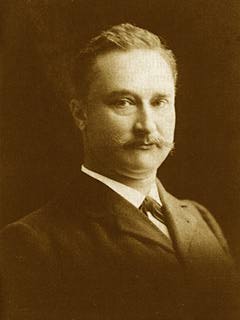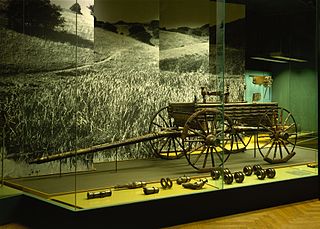Related Research Articles

Cernunnos is a Celtic god whose name is only clearly attested once, on the 1st-century CE Pillar of the Boatmen from Paris, where it is associated with an image of an aged, antlered figure with torcs around his horns.

A cauldron is a large pot (kettle) for cooking or boiling over an open fire, with a lid and frequently with an arc-shaped hanger and/or integral handles or feet. There is a rich history of cauldron lore in religion, mythology, and folklore.

Marie Eugène François Thomas Dubois was a Dutch paleoanthropologist and geologist. He earned worldwide fame for his discovery of Pithecanthropus erectus, or "Java Man". Although hominid fossils had been found and studied before, Dubois was the first anthropologist to embark upon a purposeful search for them.

Repoussé or repoussage ( ) is a metalworking technique in which a malleable metal is shaped by hammering from the reverse side to create a design in low relief. Chasing or embossing is a similar technique in which the piece is hammered on the front side, sinking the metal. The two techniques are often used in conjunction.

The Gundestrup cauldron is a richly decorated silver vessel, thought to date from between 200 BC and 300 AD, or more narrowly between 150 BC and 1 BC. This places it within the late La Tène period or early Roman Iron Age. The cauldron is the largest known example of European Iron Age silver work. It was found dismantled, with the other pieces stacked inside the base, in 1891, in a peat bog near the hamlet of Gundestrup in the Aars parish of Himmerland, Denmark. It is now usually on display in the National Museum of Denmark in Copenhagen, with replicas at other museums; it was in the UK on a travelling exhibition called The Celts during 2015–2016.

Horned helmets were worn by many people around the world. Headpieces mounted with animal horns or replicas were also worn since ancient history, as in the Mesolithic Star Carr Frontlets. These were probably used for religious ceremonial or ritual purposes, as horns tend to be impractical on a combat helmet. Much of the evidence for these helmets and headpieces comes from depictions rather than the items themselves.

The Master of Animals, Lord of Animals, or Mistress of the Animals is a motif in ancient art showing a human between and grasping two confronted animals. The motif is very widespread in the art of the Ancient Near East and Egypt. The figure may be female or male, it may be a column or a symbol, the animals may be realistic or fantastical, and the human figure may have animal elements such as horns, an animal upper body, an animal lower body, legs, or cloven feet. Although what the motif represented to the cultures that created the works probably varies greatly, unless shown with specific divine attributes, when male the figure is typically described as a hero by interpreters.

Himmerland is a peninsula in northeastern Jutland, Denmark. It is delimited to the north and the west by the Limfjord, to the east by the Kattegat, and to the south by the Mariager Fjord. The largest city is Aalborg; smaller towns include Hobro, Aars, Løgstør, Støvring and Nibe. In northeastern Himmerland is the Lille Vildmose, Denmark's largest raised bog, which sustains a rich bird life of international importance.

The archaeology of Northern Europe studies the prehistory of Scandinavia and the adjacent North European Plain, roughly corresponding to the territories of modern Sweden, Norway, Denmark, northern Germany, Poland, the Netherlands and Belgium.

Gajalakshmi, also spelt as Gajalaxmi, is a prominent representation of the goddess Lakshmi, the Hindu deity of wealth, prosperity, and fertility, depicted with two elephants on either side. This representation symbolises not only the divine blessings of wealth and prosperity but also embodies themes of fertility and royal authority.
The Chiemsee Cauldron is a gold cauldron found at the bottom of Lake Chiemsee in Bavaria, Germany, in 2001.

Iron Age Scandinavia was the Iron Age, as it unfolded in Scandinavia. It was preceded by the Nordic Bronze Age.

The Snake-witch, Snake-charmer or Smiss stone is a picture stone found at Smiss, När socken, Gotland, Sweden.
Danish art is the visual arts produced in Denmark or by Danish artists. It goes back thousands of years with significant artifacts from the 2nd millennium BC, such as the Trundholm sun chariot. For many early periods, it is usually considered as part of the wider Nordic art of Scandinavia. Art from what is today Denmark forms part of the art of the Nordic Bronze Age, and then Norse and Viking art. Danish medieval painting is almost entirely known from church frescos such as those from the 16th-century artist known as the Elmelunde Master.
The Borremose bodies are three bog bodies that were found in the Borremose peat bog in Himmerland, Denmark. Recovered between 1946 and 1948, the bodies of a man and two women have been dated to the Nordic Bronze Age. In 1891, the Gundestrup cauldron was found in a nearby bog.

The Waterloo Helmet is a pre-Roman Celtic bronze ceremonial horned helmet with repoussé decoration in the La Tène style, dating to circa 150–50 BC, that was found in 1868 in the River Thames by Waterloo Bridge in London, England. It is now on display at the British Museum in London.

The National Museum of Denmark (Nationalmuseet) in Copenhagen is Denmark's largest museum of cultural history, comprising the histories of Danish and foreign cultures, alike. The museum's main building is located a short distance from Strøget at the center of Copenhagen. It contains exhibits from around the world, from Greenland to South America. Additionally, the museum sponsors SILA - The Greenland Research Center at the National Museum of Denmark to further archaeological and anthropological research in Greenland.

Sophus Otto Müller was a Danish archaeologist.

The Dejbjerg wagon is a composite of two ceremonial wagons found in a peat bog in Dejbjerg near Ringkøbing in western Jutland, Denmark. These votive deposits were dismantled and ritually placed in the bog around 100 BCE. As of 2022, the wagon is on display at the National Museum of Denmark.

Sønderup is a village in central Himmerland, Denmark. It is located in Sønderup parish: 10 kilometers east of Aars, five kilometers south of Suldrup, and three kilometers north of Haverslev. The village is located in the Nordjylland Region and belongs to Rebild Municipality.
References
- ↑ "The Gundestrup Cauldron". National Museum of Denmark. Retrieved 27 May 2017.